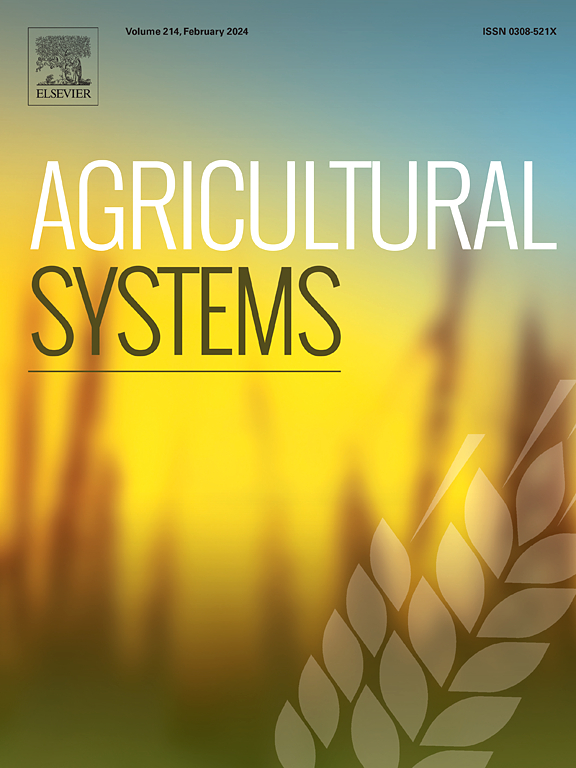非生物胁迫对韩国油菜生产的影响:从历史中吸取教训,更好地为未来气候变化的影响做好准备
IF 6.1
1区 农林科学
Q1 AGRICULTURE, MULTIDISCIPLINARY
引用次数: 0
摘要
白菜(brassica rapa)是韩国重要的经济作物。然而,气候变化对白菜生产造成了重大的非生物胁迫,导致生理效应,往往降低产量和质量。为了克服这些挑战,必须通过模拟建模和其他方法研究个别胁迫对白菜生产的影响。目的研究非生物胁迫对韩国白菜生产的影响。方法采用不同的胁迫指数模型进行比较,估计各非生物胁迫的发生规律,并评价其对大白菜生产的影响。结果和结论:我们的机器学习模型分析显示,历史上卷心菜产量的变化约62%可归因于个体非生物胁迫。近40年来(1981-2020年),各压力对生产力的相对影响没有显著变化,主要压力对生产力的影响略有增加或减少。在非生物胁迫中,低温和湿胁迫对2020年大白菜产量的影响最大,其次是干旱、高温和霜冻胁迫。基于未来气候变化情景的预测表明,HTI压力将大幅增加,超过过去40年观测到的水平,而其他压力源预计将维持在类似水平,或略有减少或增加。这项研究强调,为了确保韩国卷心菜未来的成功生产,越来越需要有效地管理这些压力源,特别是那些对生产力有较大影响且预计将超过其历史范围的压力源。本文章由计算机程序翻译,如有差异,请以英文原文为准。

Effect of abiotic stresses on Brassica rapa production in Korea: Learning from history to better prepare for the future impacts of climate change
CONTEXT
Brassica rapa, known as Kimchi cabbage, is an important cash crop in South Korea. However, climate change has inflicted major abiotic stresses on cabbage production, resulting in physiological effects that often decrease yield and quality. To overcome these challenges, the effects of individual stresses on cabbage production must be investigated through simulation modeling and other approaches.
OBJECTIVE
In this study, we aim to clarify the historical and future patterns of abiotic stress to assess its effects on cabbage production in Korea.
METHODS
To this end, different stress index models were adopted and compared to estimate the occurrence patterns of each abiotic stress and assess their impacts on cabbage production.
RESULTS AND CONCLUSIONS
Our machine-learning modeling analyses revealed that approximately 62 % of the variation in historical cabbage productivity can be attributed to individual abiotic stresses. The relative impact of each stress on productivity has not changed significantly over the past 40 years (1981–2020), with slight increasing or decreasing trends in major stresses. Among the abiotic stresses, the low-temperature injury and wetness stress have largely affected the cabbage productivity by 2020, followed by drought, high-temperature injury (HTI), and frost stresses. Projections based on future climate change scenarios suggest a substantial increase in HTI stress, surpassing the levels observed over the past 40 years, while other stressors are expected to either persist at similar levels, or decrease or increase slightly.
SIGNIFICANCE
This study underscores the increasing need to effectively manage these stressors, particularly those that have a greater impact on productivity and are projected to exceed their historical ranges, in order to ensure the successful future production of cabbage in Korea.
求助全文
通过发布文献求助,成功后即可免费获取论文全文。
去求助
来源期刊

Agricultural Systems
农林科学-农业综合
CiteScore
13.30
自引率
7.60%
发文量
174
审稿时长
30 days
期刊介绍:
Agricultural Systems is an international journal that deals with interactions - among the components of agricultural systems, among hierarchical levels of agricultural systems, between agricultural and other land use systems, and between agricultural systems and their natural, social and economic environments.
The scope includes the development and application of systems analysis methodologies in the following areas:
Systems approaches in the sustainable intensification of agriculture; pathways for sustainable intensification; crop-livestock integration; farm-level resource allocation; quantification of benefits and trade-offs at farm to landscape levels; integrative, participatory and dynamic modelling approaches for qualitative and quantitative assessments of agricultural systems and decision making;
The interactions between agricultural and non-agricultural landscapes; the multiple services of agricultural systems; food security and the environment;
Global change and adaptation science; transformational adaptations as driven by changes in climate, policy, values and attitudes influencing the design of farming systems;
Development and application of farming systems design tools and methods for impact, scenario and case study analysis; managing the complexities of dynamic agricultural systems; innovation systems and multi stakeholder arrangements that support or promote change and (or) inform policy decisions.
 求助内容:
求助内容: 应助结果提醒方式:
应助结果提醒方式:


